

The Ultimate Guide To Content Creation To Satisfy Your Audience [2025]
Content creation is one of the leading practices that have conquered the marketing world. And it makes sense if we think of how much content we consume every day while browsing the web!
To deliver great content to customers and prospects, content marketers search for creative ways to address consumers’ concerns and pain points. Their goal is to educate them and gradually gain their trust, demonstrating how their products/services can be valuable to them through blog posts, creating timeline infographics( you can use Venngage’s Free Infographic Timeline Maker), or videos.
In this guide, you’ll learn how to skyrocket your content strategy, with emphasis on:
- The importance of content creation
- Top content types to attract your audience
- Tips on how to build a content creation strategy from scratch
- Promotional practices for your content
- Tools to optimize your content creation process
Ready to dive into the details of successful content planning? Let’s get started!
What Is Content Creation?
Content creation is the process of brainstorming, crafting, and delivering content to current and potential customers to nurture them at different funnel stages.
These marketing assets can take the form of written, visual or audio content based on the topic, the buyer persona, and the customer needs you want to address each time. Later on, we’ll discuss the available content formats to choose from based on your marketing goals.
Content Creation Benefits
So why is content creation important for a business? Here are some content marketing stats from credible sources:
- Content marketing brings over three times more leads than traditional marketing practices and costs approximately 62% less. – Demand Metric
- Videos, blogs, images, and infographics are the top four content formats marketers use in their strategy. – Hubspot
- 46% of businesses stated that they want to raise their content creation spending in 2022. – CMI
Now let’s have a look at the benefits of creating high-quality content!
Generating New Leads
Lead generation is a vital process for most businesses, with content marketing being at the core of it. The more visitors get to your website through your content, the higher the chances of converting those interested in your products/services.
Let’s see one example: Imagine that a consumer with a specific question in mind runs into one of your infographics on social media. If they find your content useful, they’ll probably have a read and start a valuable interaction with your brand.
If you keep bringing your target audience to your website through good content via sources like newsletters or social media and convince them that your products or services are helpful, you can ultimately turn them into customers.
Educating Target Audience
A marketing funnel visualizes your average buyer’s journey from awareness to decision. It includes all the different steps a consumer takes before becoming a customer. Understanding the content needs of your audience in each stage will help you address the subjects they’re interested in.
For example, if you have a B2B organization and someone is at the decision stage, they need to form an important purchase decision. You can help them seal the deal by presenting an infographic with quotes from big brands using your services or a similar content piece.
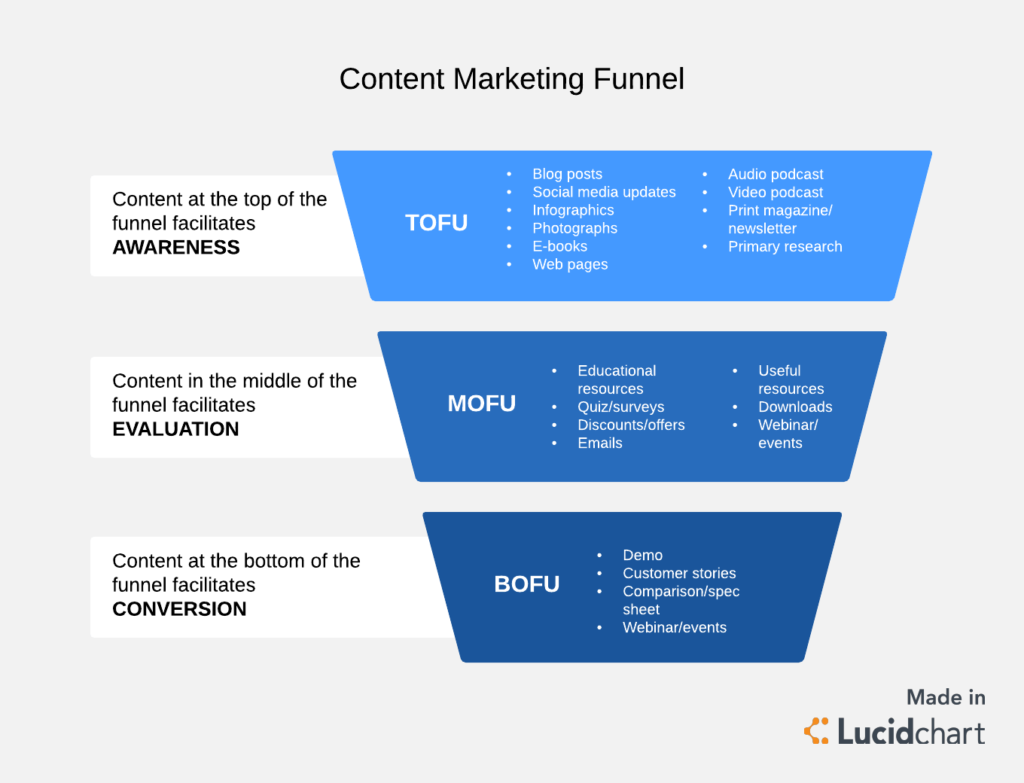
Above, you’ll find the most suitable content types for each funnel stage. We’ll share insights on most of these content formats in the next section.
Leveraging ROI
Content creation can also enhance your marketing ROI when done properly. Think of how many influencers rule social media platforms and have managed to receive their income exclusively by building and delivering great digital content.
Apart from its well-established role in brand awareness, it can also play a significant part in purchasing decisions. This is even more evident in the so-called button-funnel content.
For instance, if a prospect checks a comparison page or starts checking products thoroughly on your eCommerce store, there are probably at the decision stage. So make sure to have ready-made content to help them decide faster!
Driving Demand In Your Market
Last but not least, certain kinds of content can pinpoint how your products/services can be of great value to consumers and why they’re unique in your niche.
For example, a woman looking to switch hair products could be intrigued by an organic brand sharing beauty tips demonstrating their products and pure ingredients. And if you show them how healthy and glowy their hair will become, you can attract new buyers.
Top Content Creation Formats
Now let’s have a brief look at the most common pieces of content businesses, and freelancers create to attract, convert, and retain their customers:
Blog Posts: Short or long-form written pieces, usually in the form of tutorials or step-by-step guides with topics relevant to your audience. They can also include visual elements, such as graphs or videos.
Videos: Short clips explaining a concept in-depth vividly. They can be animated or live-action videos.
GIFs: An animated series of static images or short videos playing on the loop. They are also valuable for product demonstration.
Infographics: An image presenting data, usually including a combination of graphs and copy.
Podcasts: Episodic series of audio files, primarily available for download or streaming.
Webinars: A webinar is a digital educational event created by experts to nurture people interested in a niche market.
E-Books: A digital version of a book written for a specific purpose, such as demonstrating the results of a survey.
Testimonials: A case study or quotes from customers who’ve shaped an opinion about your brand, emphasizing benefits.
Content creators, designers, and bloggers try to determine which content format is suitable for each topic to attract the audience’s attention, motivate them to move down the funnel, and share your content with their peers. Adding calls-to-action (CTAs) to your content is necessary to make that happen more organically.
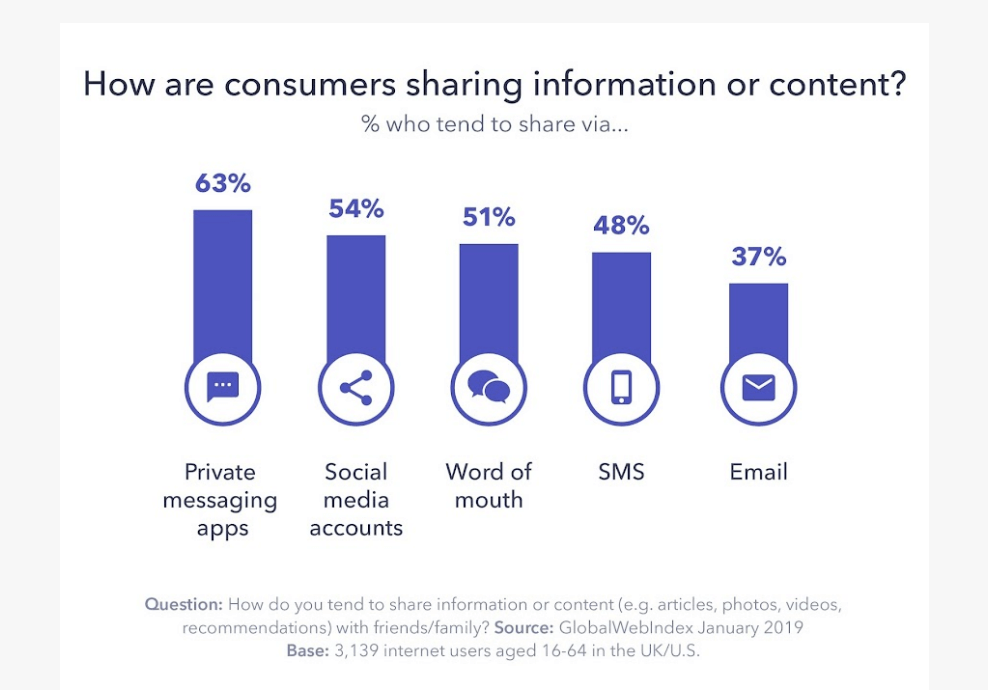
But how can you set up a successful content creation strategy to reap the benefits you long for? Let’s jump to the next section to figure it out!
Content Creation Checklist
Before we show you how to streamline your content creation, make sure to keep this checklist on hand:
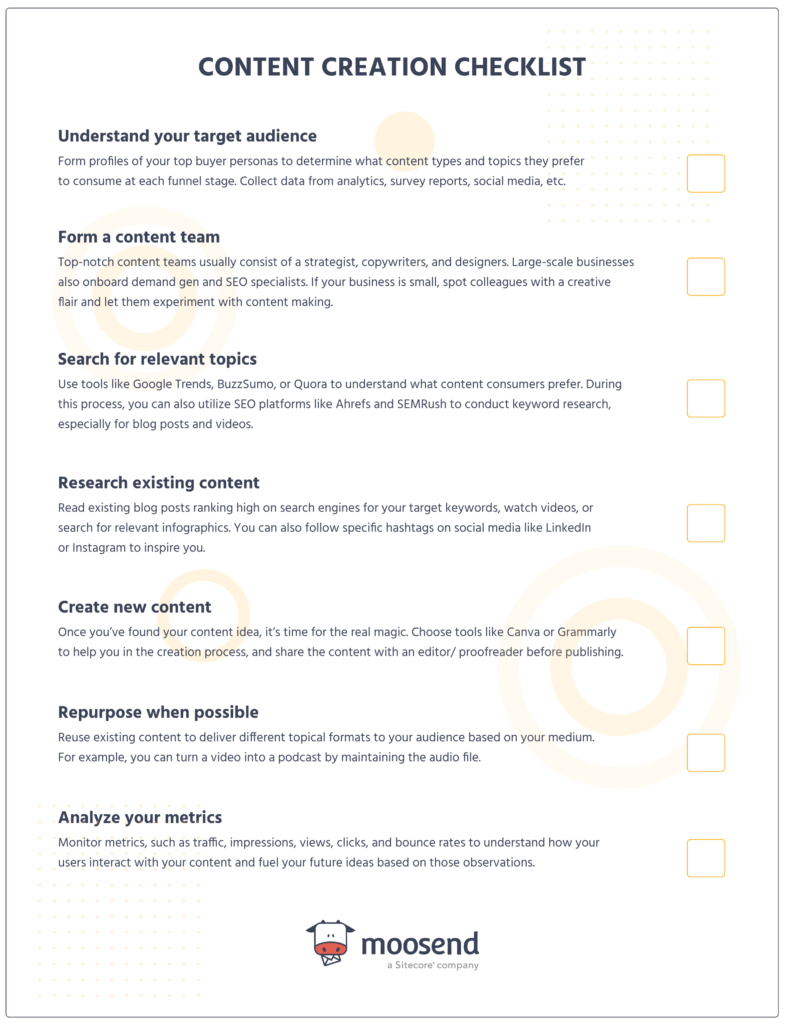
Ready to check all those boxes? Let’s do this properly!
How To Streamline A Content Creation Strategy
In this part, we’ll explore how to plan and deliver content made to bring new customers and retain existing ones. Let’s take it from the top:
1. Understand Your Target Audience
First off, you should identify your target audience and form your buyer personas. Understanding your customers’ demographics and traits will help you target them more effectively with content they will find both relevant and useful.
To build a buyer persona profile, you can combine info from various sources, such as Google Analytics, survey reports, social media listening, etc. Knowing which content types this persona prefers to consume to find solutions to existing pain points can be game-changing. You’ll be able to tailor your new content and messages based on this info to make your outreach more efficient.
Another great tool to use is customer journey maps to visualize the individual journey of your personas. This will help you determine what type of content can move them down the funnel faster and forward them to the checkout page or sales team based on the length of the customer lifecycle.
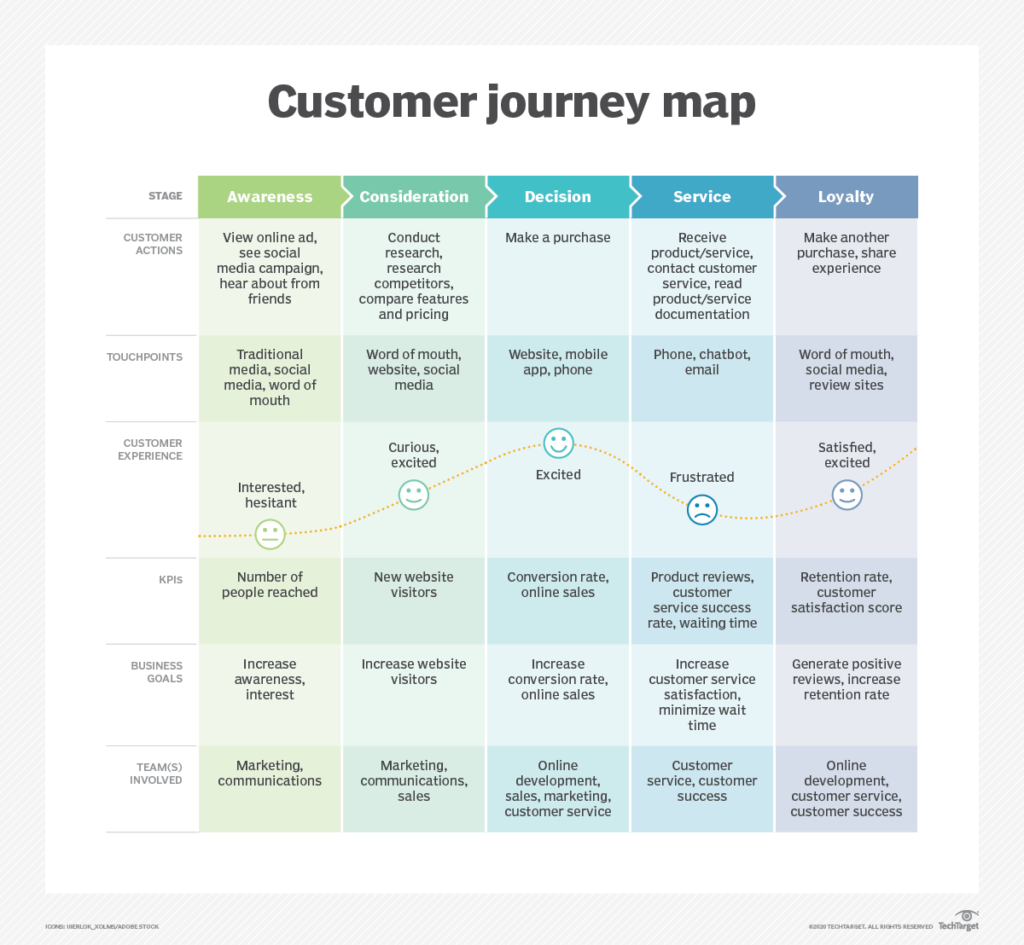
Ready to build your own maps and personas? Here’s s free tool to get started!
2. Form a Content Team
Who would be in charge of creating and delegating content from your team? In most cases, large businesses and start-ups with a solid content marketing strategy in place hire a content strategist to overview this digital marketing field.
These content marketing teams usually consist of writers, designers, and video producers responsible for bringing content ideas to life. SEO and demand gen specialists can also step in the process to make content more relevant to your target audience and visible on search engines.
However, not all businesses have the resources to employ all these roles and use more hands-on processes to build content. For example, they may use simple tools like Canva to craft visuals or share their blog posts on platforms like Medium before they build something bigger.
Moreover, many businesses collaborate partially or fully with creative agencies or partner with social media influencers to gain more visibility. If you go in that direction, ensure that your collaborators understand your target audience in-depth and don’t hesitate to give them some essential guidelines to follow.
3. Search for Relevant Topics
How can you discover what topics are interesting for your audience? Or what is trending in your niche market to stay ahead of the curve? First off, you can use Google Trends, BuzzSumo, or Quora to understand what consumers look for at a given time.
In addition, explore tools like Ahrefs and SEMRush to conduct keyword research, especially if you’re creating blog posts and videos. By inserting the primary keyword, you can detect the monthly traffic it gets and relevant questions consumers have.

If you don’t have the resources to purchase those tools, you can select free options like Ubersuggest or do the same process on your search engine.
For example, when you type a specific query on Google, a “People also ask” section usually pops in the middle of the screen, while a“Related Searches” part appears at the end.
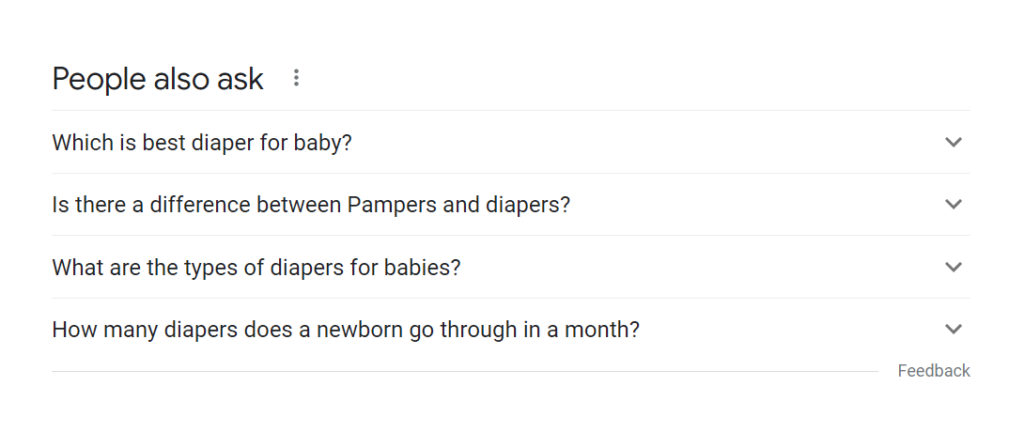
Last but not least, you can always look into customer feedback collected by your support team or via survey reports. They can show you the way to your customer’s interests and concerns.
4. Research Existing Content
If you’re close to deciding what kind of content to create and share with your audience, it’s time to see what is already online around this topic. How do other businesses, freelancers, or publishers approach this concept? Is there an angle that still needs to be covered?
You can start by reading blog posts, watching videos, or searching for infographics. Following related hashtags on social media like LinkedIn or Instagram can also inspire you. If you’re still at the beginning of your content creation process, it’s best to go for something fresh that has not been brought up extensively and get as many eyes on you as possible.
And now, it’s time to choose the best content format based on your findings and creative instincts. When making those decisions, always have your buyer personas in mind and try to sense which content they’d be naturally inclined to consume. Factors like age and gender can give you a good hint about what to produce.
Remember, existing content is a good indicator of what to create, but it’s not always the best counselor. Try to bring unique content to the table, and your audience will likely appreciate it!
5. Create New Content
Let’s move to the magical side of it all: The content creation itself! Here are the three main steps to follow:
Ideation
The ideation or brainstorming process was mainly covered in the previous section. But what happens when you feel stuck and don’t know where to start?
In general, it’s significant to have a content calendar that is ultimately aligned with your content marketing goals. Set the marketing objective each content piece will meet and monitor your success in the long run.
You can always contact different teams and colleagues in your business for inspiration, especially those who interact more with prospects, like support, social media, and the sales team. They can enlighten you more than you could imagine!
Implementation
So now you can distribute the tasks to your creative team based on the content format you’d like to build. For instance, if you’ve decided to craft an infographic, you’ll need a copywriter and a designer.
Firstly, writers will do thorough research on the given topic and write brand new copy that reflects the business’s core messaging. Then the designer steps in to craft and beautify the piece of content based on the brand guidelines.
For example, if you’re selling baby products, you can step into Pamper’s shoes, creating content about newborn babies to attract and educate customers:
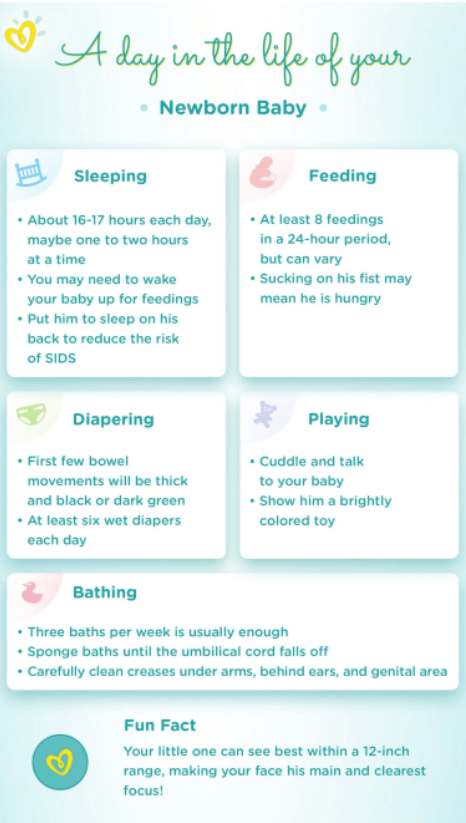
Editing
One significant step that is often overlooked is editing or proofreading, especially for long-form written content, aka blog posts. Sometimes writers fall into logical traps when narrating a story or fail to detect some typos, but you can’t risk delivering something faulty.
Before publishing new content, you should share it with one of your colleagues to see if the piece is on-point and make contextual or grammar suggestions if needed.
If no one can fill this role, you can proceed with self-editing by leaving a time gap between writing and double-checking to avoid cognitive bias drawn from familiarity with your own writing.
6. Repurpose When Possible
Content repurposing is a clever tactic allowing marketing teams to keep nurturing their audience while saving valuable time. It’s the process of turning existing content into a new format to reach a new audience and satisfy different consumer preferences – something like content recycling.
So when you have enough content of all types under your wings, think of how to reuse it. For instance, you can turn a video interview into a podcast or a blog post into an infographic. So there’s no need to stress out about finding new topics each time. Just get playful with your current resources!
7. Analyze Your Metrics
Monitoring your content marketing activities will enable you to determine what content types and topics are more effective for the audience. You can use SEO tools, Google Analytics, and social media listening platforms for this purpose.
In a nutshell, overview marketing metrics such as traffic, impressions, clicks, and bounce rates to understand how your users interact with your content in-depth.
How To Promote Your Content Like A Pro
Creating content is just one side of the coin. Once you’ve written and designed your assets, it’s time to promote them as far as possible. Let’s see some of the top methods:
Email Marketing
Email marketing is one of the most effective channels marketers use to communicate and nurture their audience. Once you get a customer’s opt-in, start interacting with them through content they’ll find both relevant and useful.
You can also send personalized emails utilizing audience management and email segmentation features. You can also tailor the content based on your audience’s preferences and other characteristics and make things personal for them.
Have a look at this campaign by Trello, with blog posts updates for subscribers:
Subject line: Conduct better remote interviews

Building beautiful newsletters is a piece of cake with the appropriate email marketing service. If you’re looking for such a solution, sign up for a Moosend account and get amazed by our features and pre-made templates for beginners and pros!
Social Media Marketing
Content and social media marketing usually go hand in hand. According to Hubspot, 71% of consumers are likely to buy from social media referrals. However, before uploading your content to different social media channels, check where your audience usually hangs out.
Moreover, keep in mind that each platform has its own rules regarding content sharing. For example, on Instagram, images and short videos prevail, while LinkedIn is suitable for more professional content.
Let’s see a social media post by Bobbi Brown on Instagram. They share a quick reminder to customers on the importance of cleaning their make-up brushes, demonstrating their products at the same time:
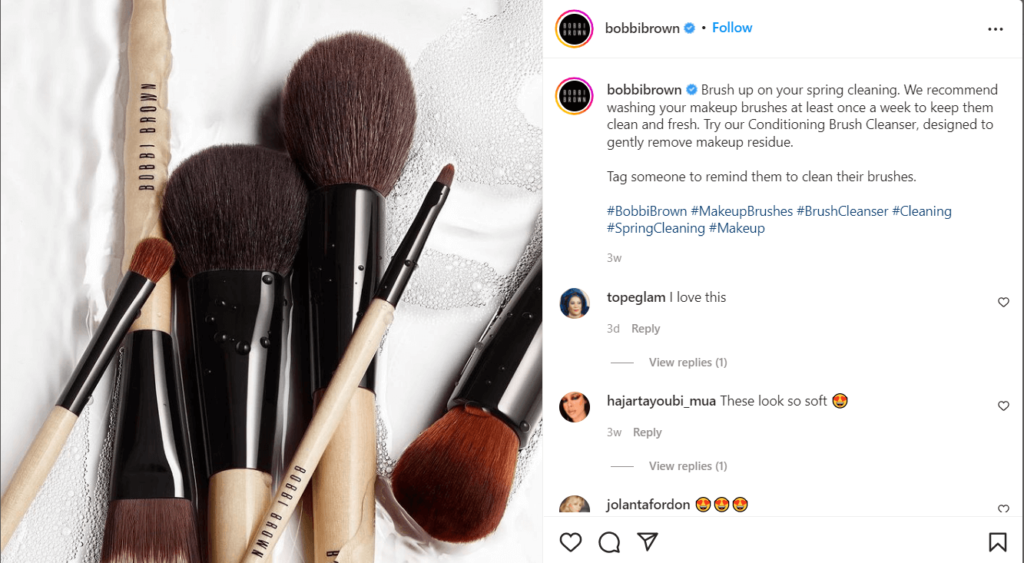
You can also create dedicated content for social media to educate your audience and give them something to wait for. For example, at Moosend we have Marketing Lab, often collaborating with notable brands in our niche market. Look at this LinkedIn post as a reference:
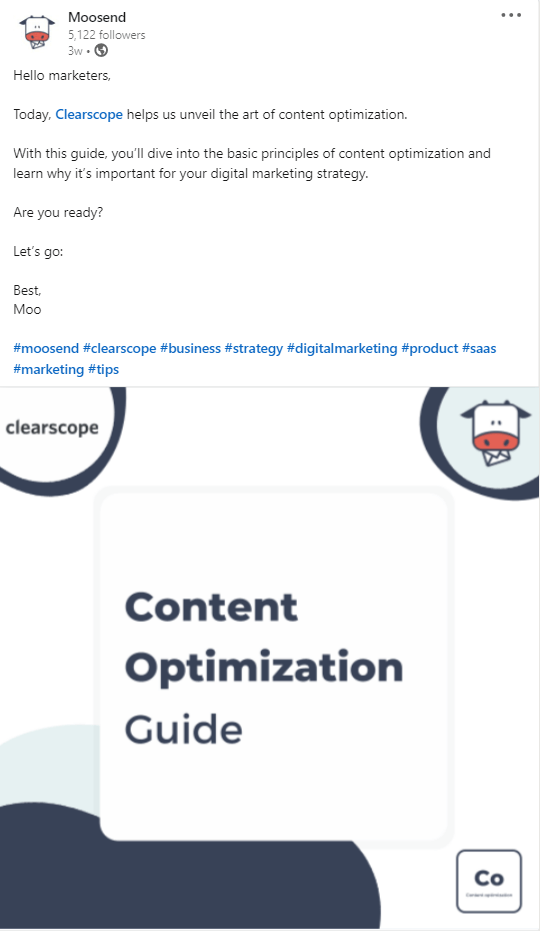
Website Optimization
Your website copy and assets play a crucial role in raising awareness around your brand and products/ services. But if you want to take it to the next level, you can mix some of your content to increase the likelihood of conversions.
You can also create a path for website visitors to your content. You can achieve this by adding buttons leading to your top resources, such as blog posts, customer testimonials, or white papers. A clever design coupled with an amazing user experience can also boost conversions.
Moreover, add social media widgets to showcase more of your diverse content and bring more traffic to your social channels, as BURGA does:

Content Creation Tools For Beginners And Pros
The question is, do you have to create all this content by yourself? Of course not, and thankfully there are many tools to help you with this process. Let’s see:
Topic Ideation: Google Trends, BuzzSumo, Quora, Sparktoro, etc.
Design: Canva, Visme, Piktochart, GIPHY, etc.
CMS: WordPress, Medium, Joomla, etc.
SEO: Ahrefs, Moz, SEMRush, Ubersuggest, etc.
Analytics: Google Analytics, Hotjar, Buffer, etc.
Video: SoapBox, Demio, Loom, etc.
Copy: Grammarly, Copy.ai, etc.
These are some of the many platforms to help you pivot your content creation. Before purchasing, check their available features in-depth and their pricing plans.
Thankfully, there are also free tools for beginners who don’t want to compromise on excellent content quality!
The Takeaways
Now that you know more about content creation and how it can rock your inbound marketing strategy, you can finally add it to your marketing workflow. Sit down with your creative team and determine what type of content your customers and prospects will find inspiring.
Building content can turn into a constructive and magical process for your team, so we dare you hit the road if you still feel hesitant about implementing it.
And by the way, if you’re looking for a cost-effective email marketing solution with great automation and segmentation features, we got your back! Sign up for a Moosend account today and get ready to shine!
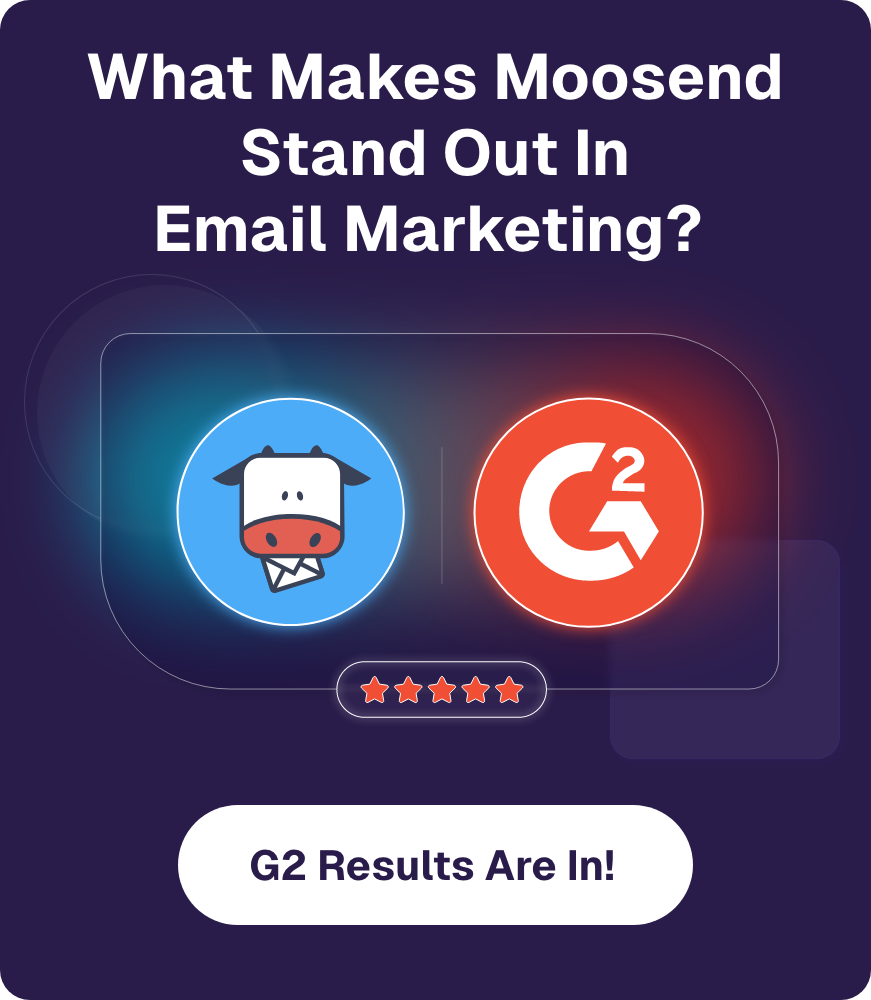



 Published by
Published by

